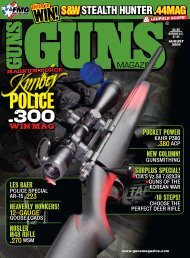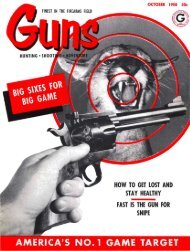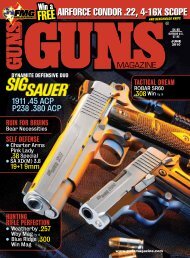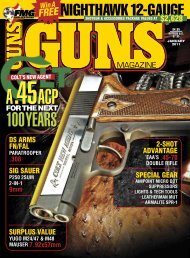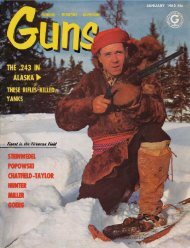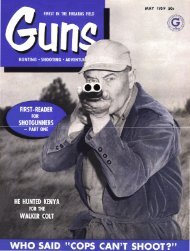Guns 2012-08.pdf - Jeffersonian
Guns 2012-08.pdf - Jeffersonian
Guns 2012-08.pdf - Jeffersonian
Create successful ePaper yourself
Turn your PDF publications into a flip-book with our unique Google optimized e-Paper software.
The trick in pronghorn<br />
hunting is to see them<br />
first, then use the<br />
landscape to stalk closer.<br />
isn’t nearly as popular as the .243<br />
Winchester, by far the most common<br />
chambering in smaller-bore big game<br />
rifles. The number was skewed partly by<br />
me and Eileen (she’s used the .257 on 40<br />
percent of her pronghorns, including<br />
her first, taken 27 years ago), but also<br />
turned up in the hands of some clients<br />
I’ve guided, who might be termed rifle<br />
loonies.<br />
After the .257 the list is dominated<br />
by common rounds such as the .243<br />
Winchester, 7mm Remington Magnum,<br />
.308 Winchester and .30-06, but a few<br />
hunters used really uncommon rounds,<br />
including the .240 Weatherby, .250<br />
Savage, 6.5 Creedmoor, 6.5/284, 6.5-06<br />
and .280 Ackley Improved. They all<br />
worked about the same, as long as the<br />
hunter could shoot.<br />
The .220 Swift worked perfectly on<br />
several antelope. It isn’t legal in some<br />
states, including Wyoming, but is in<br />
Montana. I used to bring one along<br />
when guiding, partly for coyotes but<br />
partly because some clients turned out<br />
to be over-gunned. One young man<br />
just out of high school brought his<br />
only rifle, a .338 Winchester Magnum,<br />
purchased because of his dream of<br />
being an Alaskan guide.<br />
Scott couldn’t hit squat with his .338,<br />
due to severe flinching, so I introduced<br />
him to the Swift, a well-used tang-safety<br />
Ruger 77. It shot 60-grain Nosler Solid<br />
base bullets quite accurately at 3,650<br />
fps, and after a few test shots to cure<br />
Scott’s flinch, we went hunting, stalking<br />
within 150 yards of a very good buck.<br />
At the shot the buck trotted in a tiny<br />
circle, then fell over dead due to a hole<br />
through both sides of his ribcage, just<br />
as if he’d been shot with a .243, .270 or<br />
7mm Magnum.<br />
The only reason the .300 WSM<br />
appeared on the list was my using<br />
it on a couple of hunts hosted by<br />
firearms manufacturers—which brings<br />
up another interesting point. A lot of<br />
hunters choose lighter, more frangible<br />
bullets for hunting pronghorns, both for<br />
a flatter trajectory and to insure bullet<br />
expansion at long range on relatively<br />
light animals. Over the decades,<br />
however, Eileen and I have almost<br />
entirely switched to harder bullets, and<br />
sometimes to heavier, slower bullets.<br />
Why? Because they don’t shoot up as<br />
much meat.<br />
Truly Tasty<br />
Pronghorns taste really good—<br />
though some hunters don’t believe<br />
this, either because of the way they<br />
smell on the outside (the reason for<br />
“stink-goat”) or because the hunters<br />
don’t know how to take care of the<br />
meat. Pronghorn meat is easily ruined<br />
by any little screw-up in the field, from<br />
gut-shooting to not cooling the meat<br />
down quickly. Since hunting seasons<br />
often take place in late summer and<br />
early fall the weather’s often warm, so<br />
removing the hide quickly really helps.<br />
Pronghorn hair is hollow, like that<br />
of deer, but each hair is even thicker,<br />
the reason 100-pound pronghorns<br />
can easily withstand the below-zero<br />
temperatures typical of winter on the<br />
high plains. The fragile hair also has a<br />
distinct goaty aroma that doesn’t help<br />
the flavor of pronghorn meat, and the<br />
dried blood also turns bitter. The meat<br />
should be rinsed immediately after<br />
skinning, one reason so many truly<br />
experienced pronghorn hunters carry<br />
plenty of water.<br />
When properly cared for pronghorn<br />
is among the finest of game, mildflavored<br />
and very tender, but even<br />
mature bucks rarely yield much more<br />
than 40 pounds of boned meat.<br />
Ruining 5 or 10 pounds with an<br />
explosive bullet makes a big difference.<br />
Over the past few years Eileen has used<br />
Barnes Triple-Shock and Nosler E-Tip<br />
bullets in her rifles. I’ve used both as<br />
well, but another good example might<br />
be the two bucks taken with the .300<br />
WSM.<br />
The first was on a hunt where<br />
every writer was issued ammo loaded<br />
with 150-grain Nosler Ballistic Tips.<br />
Now, Ballistic Tips are fine bullets,<br />
but they do tend to chew up meat,<br />
especially when started from a .300<br />
Magnum, and I lost at least 6 to 8<br />
pounds off my buck, despite putting<br />
the bullet through the ribs behind the<br />
shoulder. On my next invitation to<br />
hunt pronghorns with the .300 WSM<br />
I used ammo loaded with 180-grain<br />
Nosler AccuBonds, punching a nice<br />
hole through the ribs and leaving the<br />
shoulder meat intact.<br />
Yeah, we can obsess over every detail<br />
of our pronghorn rifle, but thanks to<br />
laser rangefinders, ballistic reticles and<br />
reliable elevation turrets, a super-flat<br />
trajectory isn’t nearly as helpful for<br />
pronghorn hunting as it used to be.<br />
Shots at 400 yards or more can easily<br />
be made even with pedestrian rounds<br />
like the .308 Winchester. But if using<br />
the “perfect” pronghorn rifle makes<br />
you happy, by all means go ahead. One<br />
of my recent bucks fell to a custom 6.5-<br />
06 with a 10X Leupold Mark 4 scope,<br />
all dialed-in out to 700 yards, shooting<br />
a 140-grain Berger VLD at 2,950 fps.<br />
It worked just fine—at 163 yards.<br />
In reality just about any deer rifle,<br />
shooting spitzer bullets at 2,700+ fps<br />
will also do the trick, as long as our<br />
laser accurately measures the range—<br />
and we find our pronghorn before it<br />
finds us, then use the Western landscape<br />
to stalk within sure range.<br />
44<br />
WWW.GUNSMAGAZINE.COM • AUGUST <strong>2012</strong>




